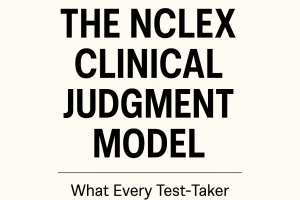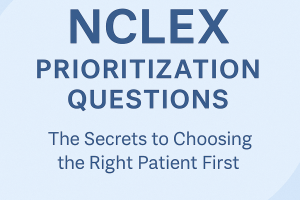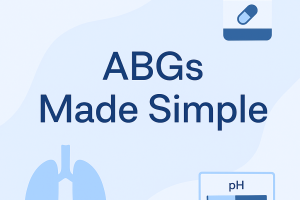Understanding the NCLEX-RN Test Plan: A Comprehensive Guide

Understanding the NCLEX-RN Test Plan: A Comprehensive Guide
Introduction
Preparing for the NCLEX-RN can feel overwhelming, especially when faced with its complex structure and extensive content. The NCLEX-RN (National Council Licensure Examination for Registered Nurses) is designed to ensure nursing graduates are competent and ready to provide safe and effective care. At the heart of this exam lies the NCLEX-RN Test Plan, a critical document that guides its creation and structure.
Understanding the NCLEX-RN Test Plan is essential for exam success. This guide will break down its components, explain its significance, and provide actionable tips to help you use it effectively in your preparation.
1. What Is the NCLEX-RN Test Plan?
The NCLEX-RN Test Plan is a blueprint created by the National Council of State Boards of Nursing (NCSBN) to outline the content and framework of the exam. Updated every three years, it reflects current nursing practices and ensures the exam aligns with the evolving healthcare environment.
Key aspects of the test plan include:
• Client Needs Categories: The foundation of the exam, covering major aspects of nursing care.
• Test Format and Structure: Explaining the use of Computerized Adaptive Testing (CAT) and question types.
• Focus on Safe and Effective Care: Emphasizing critical thinking and clinical decision-making skills.
By understanding the test plan, candidates can tailor their preparation to align with the exam’s focus areas.
2. The NCLEX-RN Test Plan Structure
The NCLEX-RN is structured around four main Client Needs categories, further divided into subcategories:
• Safe and Effective Care Environment
• Management of Care (17–23%): Topics like prioritization, delegation, and ethical practice.
• Safety and Infection Control (9–15%): Covers precautions, error prevention, and client safety.
• Health Promotion and Maintenance (6–12%)
Topics include growth and development, health screenings, and lifestyle choices.
• Psychosocial Integrity (6–12%)
Focuses on emotional and mental health, including coping mechanisms and therapeutic communication.
• Physiological Integrity
• Basic Care and Comfort (6–12%): Assisting clients with daily living needs.
• Pharmacological and Parenteral Therapies (12–18%): Medication administration and related topics.
• Reduction of Risk Potential (9–15%): Identifying complications and risks.
• Physiological Adaptation (11–17%): Managing chronic and acute conditions.
Each section represents a percentage range of the exam, emphasizing the importance of allocating study time proportionally.
3. Key Features of the Test Plan
• Integrated Processes: Nursing processes (assessment, planning, implementation, evaluation), communication, culture, and teaching/learning concepts are woven throughout all categories.
• Test Complexity: Questions range from recall and application to analysis and synthesis, challenging candidates to think critically.
• Alternate Format Questions: Besides multiple-choice, you’ll encounter select-all-that-apply, drag-and-drop, and hotspot questions.
Understanding these features helps in anticipating question types and identifying skills to develop during preparation.
4. How to Use the NCLEX-RN Test Plan Effectively
• Familiarize Yourself with the Test Plan: Download the official document from the NCSBN website and review it thoroughly.
• Identify Strengths and Weaknesses: Use the plan to assess your understanding of each content area. Focus your studies on weaker sections.
• Incorporate Practice Questions: Use NCLEX-style questions to test your knowledge and improve your critical thinking skills.
• Simulate Exam Conditions: Practice under timed conditions to get used to the CAT format and build confidence.
• Stay Updated: Ensure your study materials align with the current test plan version.
A strategic approach rooted in the test plan will maximize your chances of success.
5. Common Misconceptions About the NCLEX-RN Test Plan
• Myth: “It’s just a content list.”
Fact: The test plan is more than a content list; it provides insights into how questions are framed and evaluated.
• Myth: “The focus is only on nursing knowledge.”
Fact: The exam also assesses critical thinking, prioritization, and decision-making skills.
Understanding these nuances ensures your preparation goes beyond rote memorization.
Sample Questions
Question 1
A nurse is delegating tasks to an unlicensed assistive personnel (UAP). Which task is most appropriate to delegate?
• A. Administering medications to a stable client.
• B. Measuring and recording a client’s vital signs.
• C. Educating a client on insulin self-administration.
• D. Assessing a client’s surgical wound.
Answer: B. Measuring and recording a client’s vital signs.
Question 2
Which of the following is the priority nursing action for a client reporting chest pain?
• A. Administer pain medication.
• B. Apply oxygen and monitor oxygen saturation.
• C. Notify the healthcare provider immediately.
• D. Encourage the client to rest and decrease activity.
Answer: B. Apply oxygen and monitor oxygen saturation.
Question 3
A client with diabetes mellitus has a blood glucose level of 56 mg/dL. Which is the nurse’s priority action?
• A. Reassess blood glucose in 15 minutes.
• B. Administer 4 ounces of juice.
• C. Notify the healthcare provider.
• D. Provide a carbohydrate-rich meal.
Answer: B. Administer 4 ounces of juice.
Question 4
When teaching a client about medication safety, which of the following is most important?
• A. Store medications in a visible, accessible location.
• B. Share medications with family members if symptoms are similar.
• C. Follow the prescribed dose and schedule.
• D. Take over-the-counter medications without consulting a healthcare provider.
Answer: C. Follow the prescribed dose and schedule.
Question 5
A nurse is prioritizing care for clients. Which client should the nurse see first?
• A. A client with a scheduled dressing change.
• B. A client who is 2 hours post-op and restless.
• C. A client with a medication question.
• D. A client requesting assistance with ambulation.
Answer: B. A client who is 2 hours post-op and restless.
Conclusion
The NCLEX-RN Test Plan is an invaluable resource for candidates aiming to pass the exam and become licensed nurses. By understanding its structure, content areas, and features, you can create a targeted study strategy that addresses your strengths and weaknesses. With the right preparation and mindset, success is within reach.
Remember, the NCLEX is not just a test of knowledge but also an evaluation of your ability to think critically and provide safe, effective care. Use this guide to navigate the test plan and confidently embark on your journey to becoming a registered nurse.






